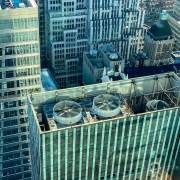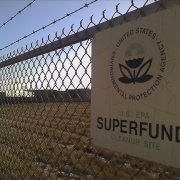HotSpots H2O: U.S. Great Lakes, Near Record Highs, Pummel Coastal Infrastructure
Lake Michigan, United States. Photo © J. Carl Ganter/Circle of Blue
The U.S. Great Lakes have surged to unprecedented levels, causing tens of millions of dollars in damage to coastal roads, marinas, and household property. Even more assets could be at risk, owing to forecasts that the swell is likely to continue through the spring and early summer.
“We’re definitely looking at another tough year,” warns Lauren Fry, lead lake level forecaster at the U.S. Army Corps of Engineers Detroit district office. “Even if we saw the driest 12-month water level sequence we’ve ever seen, we’ll still be pretty well above average.”
Data compiled by the Michigan Municipal League estimates that total damages from high lake levels have totaled $63 million so far. Transportation officials in the state warn that long-term roadway damages could amount to $100 million.
Lakes Michigan and Huron set monthly records for each of the first three months in 2020, while Lake Superior reached new monthly highs in January and February, and Lake Erie set a February record. The previous records were set in the late 1980s.
Forecasts for the next several months warn that the lakes could continue that record-setting streak. If spring rains are heavy, meteorologists say the lakes could reach the highest levels since 1918, the year that accurate data-keeping began.
For more than a year, all five of the major lakes have measured roughly a foot or more above average. Water has already inundated parts of Michigan’s 3,288 miles of shoreline.
The city of South Haven is among the worst hit, with damages of around $16 million. In mid-March, the city announced that its marina will close for the 2020 summer season due to electrical issues.
“High water has compromised the shore power electric system, which could cause shock or electrocution if someone were to come into contact with the water,” Katie Hosier, assistant city manager and harbormaster, explained in a news briefing.
Other towns, including Muskegon and Frankfort, have sustained damages of $10 million or more.
Issues caused by high water levels include road, trail and beachfront erosion, disruptions to stormwater systems and utilities, and widespread flooding.
Coastal communities are rushing to repair and protect their shorelines, but the initiative is being complicated by the Covid-19 pandemic. In Michigan, most staff members of the Department of Environment, Great Lakes and Energy are currently working from home. Physical distancing and other preventative measures are also disrupting shoreline repairs.
The pandemic is also forcing the Red Cross, which provides shelter to those displaced by disasters like flooding and fires, to reevaluate its shelter plans. Typically, the organization relocates people to large facilities like gymnasiums. Physical distancing rules could restrict the number of people who can be sheltered in a facility.
Ultimately, the extent of damages caused by lakeshore flooding and erosion will largely depend on precipitation over the next several months. If the region experiences a wetter-than-average spring, many popular Great Lakes beaches–along with parts of the communities built around them–could be submerged.
Kayla Ritter is a recent graduate of Michigan State University, where she studied International Relations and Teaching English to Speakers of Other Languages. She is currently based in Manton, Michigan. Kayla enjoys running, writing, and traveling. Contact Kayla Ritter












Leave a Reply
Want to join the discussion?Feel free to contribute!